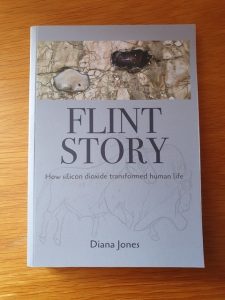The fascinating story of flint in the South Downs
February 11, 2025
The story of South Downs flint and its pivotal role in human civilisation has been uncovered in a fascinating new book.
Diana Jones penned “Flint Story” after carrying out an excavation of a large collection of flint tools in West Sussex as part of her university dissertation.
Diana explained: “I found studies of flint to be highly specialised and not very accessible, so set out to write a narrative for people who’d never thought of prehistoric flint, and what it had enabled humans to do, as a subject of interest.”
 The book describes how flint was formed in the chalk and how human-worked tools made from flint first came to be recognised in Europe. It relates stories of Ice Age landscapes, mines and firelighting, as well as accounts of antiquarians, collectors and experimenters. The book highlights the phenomenal range of objects fashioned with tools, often inspired by interconnectivity with nature’s creatures and processes: from cave, rock shelter and portable art to hunting weapons, personal adornment and the first musical instruments.
The book describes how flint was formed in the chalk and how human-worked tools made from flint first came to be recognised in Europe. It relates stories of Ice Age landscapes, mines and firelighting, as well as accounts of antiquarians, collectors and experimenters. The book highlights the phenomenal range of objects fashioned with tools, often inspired by interconnectivity with nature’s creatures and processes: from cave, rock shelter and portable art to hunting weapons, personal adornment and the first musical instruments.
Diana, who is an independent researcher with a degree in landscape archaeology from Sussex University, said: “Walking the hump-backed contours of the South Downs may be one of our greatest outdoor pleasures, but how many of us know about a once vital human resource buried deep beneath its springy turf?
 “Flint is most evident in the eroding chalk cliff faces at coastal sites such as Cuckmere Haven or Birling Gap. It’s a cryptocristalline mineral that bears an incredibly long legacy of use for toolmaking – in Britain, stretching back almost a million years. But it was also a mineral that knew no boundaries. Its slow evolution in the hands of early humans was enacted in similar ways throughout the European continent, to which we were so often attached, as well as around the world.”
“Flint is most evident in the eroding chalk cliff faces at coastal sites such as Cuckmere Haven or Birling Gap. It’s a cryptocristalline mineral that bears an incredibly long legacy of use for toolmaking – in Britain, stretching back almost a million years. But it was also a mineral that knew no boundaries. Its slow evolution in the hands of early humans was enacted in similar ways throughout the European continent, to which we were so often attached, as well as around the world.”
Diana added: “A good place to start your appreciation of flint is to visit Worthing Museum, which has a great collection of prehistoric tools, as well as a display about self-taught, local archaeological hero John Pull.”
Flint Story is available from Natural History Book Service
